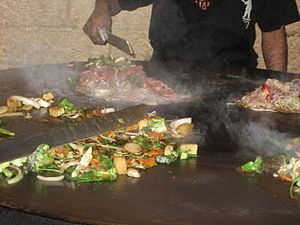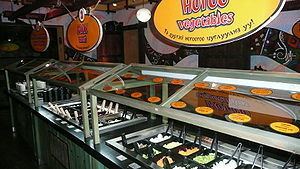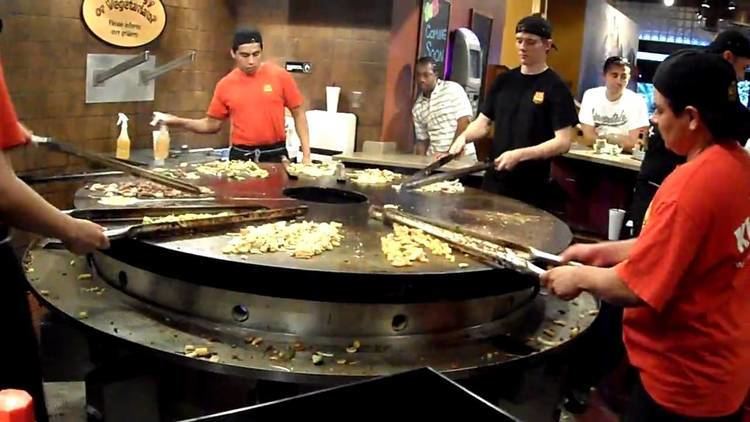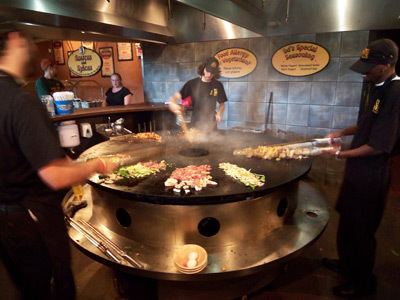 | ||
Similar | ||
Mongolian barbecue (Chinese: 蒙古烤肉; pinyin: Měnggǔ kǎoròu) is a stir fried dish that was developed in Taiwanese restaurants beginning in the early 1950s. Meat and vegetables are cooked on large, round, solid iron griddles at temperatures of up to 300 °C (572 °F). Despite its name, the cuisine is not Mongolian, and is only very loosely related to barbecue.
Contents

Mongolian barbecue artists in ulaanbaatar
Origins

Although Mongolian barbecue first appeared in Taipei in 1951, the stir-frying of meats on a large, open surface is supposed to evoke Mongolian foods and Mongolian traditions. The preparation can also derive from Japanese-style teppanyaki, which was popular in Taiwan at the time. One of the oldest Mongolian Barbecue restaurants (Genghis Khan Mongolian BBQ) was opened in the 1960s, and is located in downtown Taipei, Taiwan. As Mongolian Barbecue became more popular, it was successfully introduced to the West.

American restaurants, such as HuHot Mongolian Grill and BD's Mongolian Grill, claim that soldiers of the Mongol Empire gathered large quantities of meat, prepared them with their swords and cooked them on their overturned shields over a large fire. A German restaurant chain with the same concept claims that the Mongolian soldiers cooked their meals on a heated stone.
Preparation

Typically, diners choose various ingredients from a display of thinly sliced raw meats (beef, pork, lamb, turkey, chicken, shrimp) and vegetables (cabbage, tofu, sliced onion, cilantro, broccoli, and mushrooms, pineapple, lychee), and put them in a bowl or on a plate. These ingredients are given to the chef who adds the diner's choice of sauce and transfers them to the grill.

The shape of the grill (round) allows two or more chefs to cook food quickly and coupled with the thin slicing of meat, typically allows food to be cooked thoroughly in one revolution of the round grill. Oil and sometimes water may be added to ease cooking. The ingredients are stirred continuously over the high heat and all food remains identifiable and intact.

Some American chains such as BD's place the food (sometimes in a special wedge shaper) on different parts of the round grill. Each dish will be stirred in its turn, as the operator walks around the outside of the grill and turns each individual diner's food in succession however this method tends to result in a shredded meat bowl and if left too long, sauces tend to caramelize quickly.
Regardless of the method, the ample size of the round grill allows for several diners' food to be cooked simultaneously.
When cooking is complete, each finished dish is scooped into a bowl and handed to the diner. Many Mongolian barbecue restaurants feature an "all-you-can-eat" buffet format.
Restaurants
In Taiwan, a number of restaurants exist that specialize in Mongolian barbecue with additional buffet items available as well. These establishments often have names evoking the Mongol Empire such as Great Khan (大可汗) or Temüjin (鐵木真). The peak popularity of these restaurants was in the 1980s and 1990s.
In the United States, Mongolian barbecue is often found in American Chinese buffet restaurants, but some businesses focus primarily on the barbecue such as HuHot Mongolian Grill, BD's Mongolian BBQ and Genghis Grill.
Jingisukan
In Japan, a similar dish to Mongolian barbecue called Jingisukan (ジンギスカン, "Genghis Khan") (Mongolian: Chinggis Khaan "Чингис Хаан") is prepared with mutton and cooked on a convex metal skillet. The dish is particularly popular on the northern island of Hokkaidō. The dish is rumored to be so named because in prewar Japan, lamb was widely thought to be the meat of choice among Mongolian soldiers, and the dome-shaped skillet is meant to represent the soldier's helmets that they purportedly used to cook their food.
